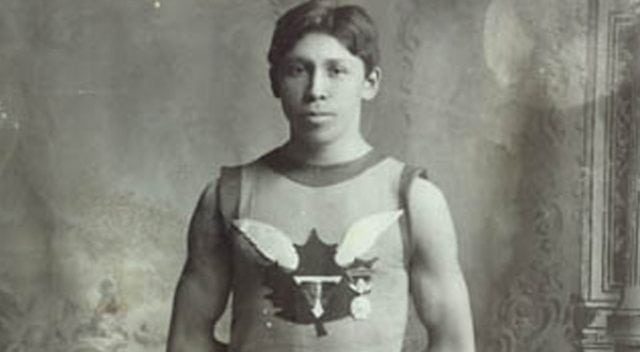Quick Facts
| Net Worth | Not Known |
| Salary | Not Known |
| Height | Not Known |
| Date of Birth | Not Known |
| Profession | Athletes |
Tom Longboat was one of the greatest long distance runners of all time. He is also one of the most notable Indians to ever participate in sports and render selfless service to the Canadian Army. Longboat’s career was so impressive that he lost only three races in his career. He was said to have beaten everyone in his generation and set records upon records. He was fondly called the “bulldog of Britannia.”
The everlasting legend Longboat is celebrated annually on his birthday which is called the Tom Longboat Day on June 4th in Ontario. Let’s take you through everything there is to know about the distance runner from his early years to his last days.
Who Was Tom Longboat? – Bio
The legend was born Thomas Charles Longboat on the 4th of June, 1887. He was a member of the wolf clan of the Onondaga Nation. His native Iroquois name was Cogwagee which means “everything.” The Longboat family lived on a small farm which was also their source of livelihood. Longboat began working on the farm from the age of 5 after his father passed away.
There is a tale that his running prowess developed while he was chasing cows in the meadow and that he has raced from Hamilton to Brantford which was sixty-five kilometers while trying to get home before his mother who journeyed by wagon. When he was 12, he was enrolled at the Mohawk Institute Residential School which was mandatory under the Indian Act at that time. However, harsh conditions at the school saw Longboat elope to live with an uncle.
He began his athletic career in 1905, coming second place at his first race on Victoria Day race at Caledonia. His interest in running had been sparked by another resident of the six-nation reserve, Bill Davis who finished second in the Boston Marathon in 1901. Longboat would go on to win the Bay Road Race in Hamilton, in Ontario in 1906. However, his mind was on the Boston Marathon which was regarded as one of the most important races at that time.
Longboat kept his eye on the goal and in 1907, he won the Boston Marathon becoming the first runner in the First Nations to achieve such a feat. He had to wrestle against the cold, snow and the rugged hills on the way to clinch the first position in a record time of 2:24:24. This was the race that brought him to the limelight. His record remained unbroken till the racing course was changed.
Tom Longboat fell a step from glory when he was unable to make it to the finish line of the 1908 Olympics Marathon as he collapsed alongside several runners. However, at the second time of asking, Longboat emerged as the winner of the rematch which took place at the same location at Madison Square Garden in New York.
After winning the race, Tom Longboat went professional with his running career in 1909. Throughout his amateur career, he lost just 2 races. For his first professional race, Longboat defeated Dorando Piertri and Alfred Shrubb to win the professional Champion of the World title in 1910 making Shrubb eventually become his greatest rival. For all the 10 times he raced against Shrubb on the 20-mile race, Longboat won but lost all of the short course races against his colleague.
As a pro, Longboat had a long winning streak and was nicknamed “the streak of bronze to Wildfire’’. He was, however, labeled lazy due to his method of training which was condemned for mixing hard days of intense training with lower stress days of mild exercise and rest. However, this method would become popular among modern-day athletes.
During his lifetime as a long distance runner, he was always plagued with racism and biting criticisms. Despite his celebrity status, longboat still offered to serve his country Canada during the World War 1. He worked as a dispatch carrier with the 107th Pioneer Battalion in France running messages and orders between units.
He was able to keep in shape by participating in inter-battalion sporting contests. He won the eight-mile race at the 1918 Canadian Corps Dominion Day competitions. After the world war, Tom Longboat brought an end to his incredible career, retiring in 1919.
How Did He Die? Here Are The Facts
Tom Longboat was twice in his lifetime a victim of a death hoax and worse, impersonation. On one of the times when Longboat was falsely declared dead, the story had it that he had been trapped for 6 days in a communication trench buried by an exploding shell during his time serving in the World War I. Longboat debunked the story in 1919.
Upon reaching Canada after the war, Tom Longboat discovered that his wife Lauretta Maracle whom he had married in 1908 before enlisting in the army had remarried another man. Lauretta had believed the false news that her husband was dead and remarried in 1918. Though she was elated that Longboat was well, she had no intentions of leaving her new husband.
Longboat would then marry another woman named Martha Silversmith. With her, he had four children. The family lived in Toronto where Longboat worked in the street cleaning department until 1944.
Tom Longboat died of pneumonia on the 9th of January 1949 while living in the Six Nation Reserve in Ontario where he had retired. Several years after his death a sum of ten thousand dollars was received by Longboat’s heirs. This was the prize money for the Boston Marathon plus interest over the years.
Tom Longboat has been honored with a number of posthumous awards. He was inducted to the Canadian Sports hall of fame as the greatest long-distance runner in 1955. A Tom Longboat Award was established by Jan Eisenhardt to honor annually outstanding sportspersons from the First Nations. Longboat was designated a National Historic Person in 1976.
On his posthumous birthday in 2018, Google used a Doodle to celebrate him across Canada and The United States of America.
Top 3 Richest Athletes
>>> View Top 10 Richest Athletes In The WorldAlso Read: Top 10 Richest People in the world with full biography and details.




